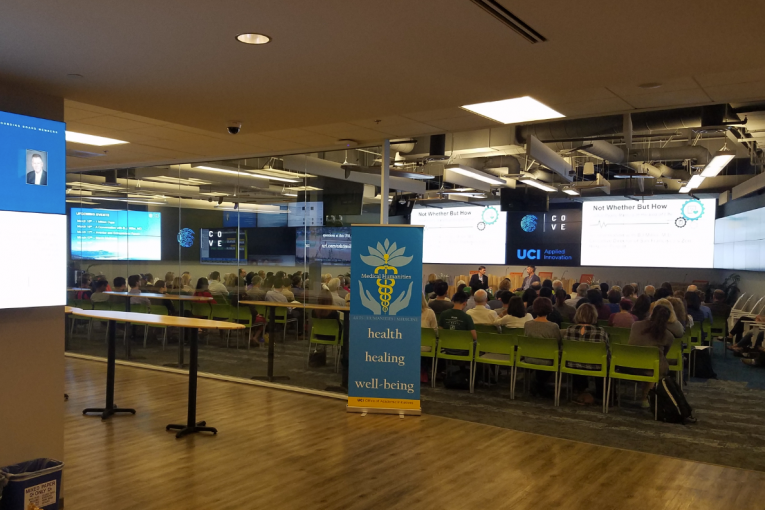
by Jeff Boone
The Cove
I just came back from a business trip to Irvine where my company co-sponsored an event at the gleaming new UCI Applied Innovation center (“The Cove” http://innovation.uci.edu/ ). The agenda included presenters that were top government officials from the US Patent and Trademark Office (USPTO) and the Small Business Administration (SBA). Also included were local leaders in venture capital and angel investors, as well as several entrepreneurs that had started and grown successful tech business ventures. There were 300 primary attendees, 100 overflow attendees and another 400 online attendees (many of The Cove events are simulcast). The backgrounds of the attendees were highly diverse.
I left this event with several impression points.
The first was the level of commitment and the related synchronicity of vision and purpose demonstrated by everyone involved. It was truly inspiring just to be hanging out there. You got the feeling that energy was building and that everyone was moving in the same direction and at an accelerating pace. Innovation was certainly in the air.
The UCI Applied Innovation center vision statement is: “Connecting resources to drive innovation”.
The mission statement is: “UCI Applied Innovation brings campus-based discoveries together with Orange County’s vibrant business community to support job creation and economic growth”.
The last part of this mission statement was very pleasing for me to see. It was emphasized several times over the course of the event and in talking to Richard Sudek, Ph. D., the visionary that built The Cove and directs its operation. Supporting job creation and economic growth for the Orange County region is the ultimate driver and the ultimate target for everything they do. The attendees and presenters all echoed this sentiment and commitment.
My next impression point was the actual facility.
On the website for The Cove there is a quote by Richard that further defines their purpose: “We are creating a microcosm of Orange County’s entrepreneurial ecosystem under one roof with incubators and accelerators, angel investors and venture capitalists, mentors and legal experts – all the resources and expertise new business needs to succeed.”
They call it a “safe harbor” for entrepreneurs.
The Cove is certainly impressive. With a beach theme (get it… “The Cove”, “safe harbor”?) It occupies 31,000 square feet of a flex-space office building within the 56-acre University Research Park. The University Research Park is conveniently located near the I-215/Highways 91 and 60 interchange, and approximately two miles from the University of California, Riverside campus.
The facility is designed to be a comfortable, high-tech, collaborative work and event space that fosters discovery, prototyping, funding, incubation and acceleration of business (this is the basic pre-launch lifecycle for new innovation business).
Only completed about a year ago, the facility is already fully occupied. The phase-II plan is to occupy the entire 40,000 square feet of the building next door. And eventually they expect to develop and utilize 200,000 square feet.
The following pictures will help better explain the space:
The main event hall with its mega-video wall

A smaller meeting room wired for high-bandwidth video teleconferencing:

Office suites occupied by start-up companies and related service providers:
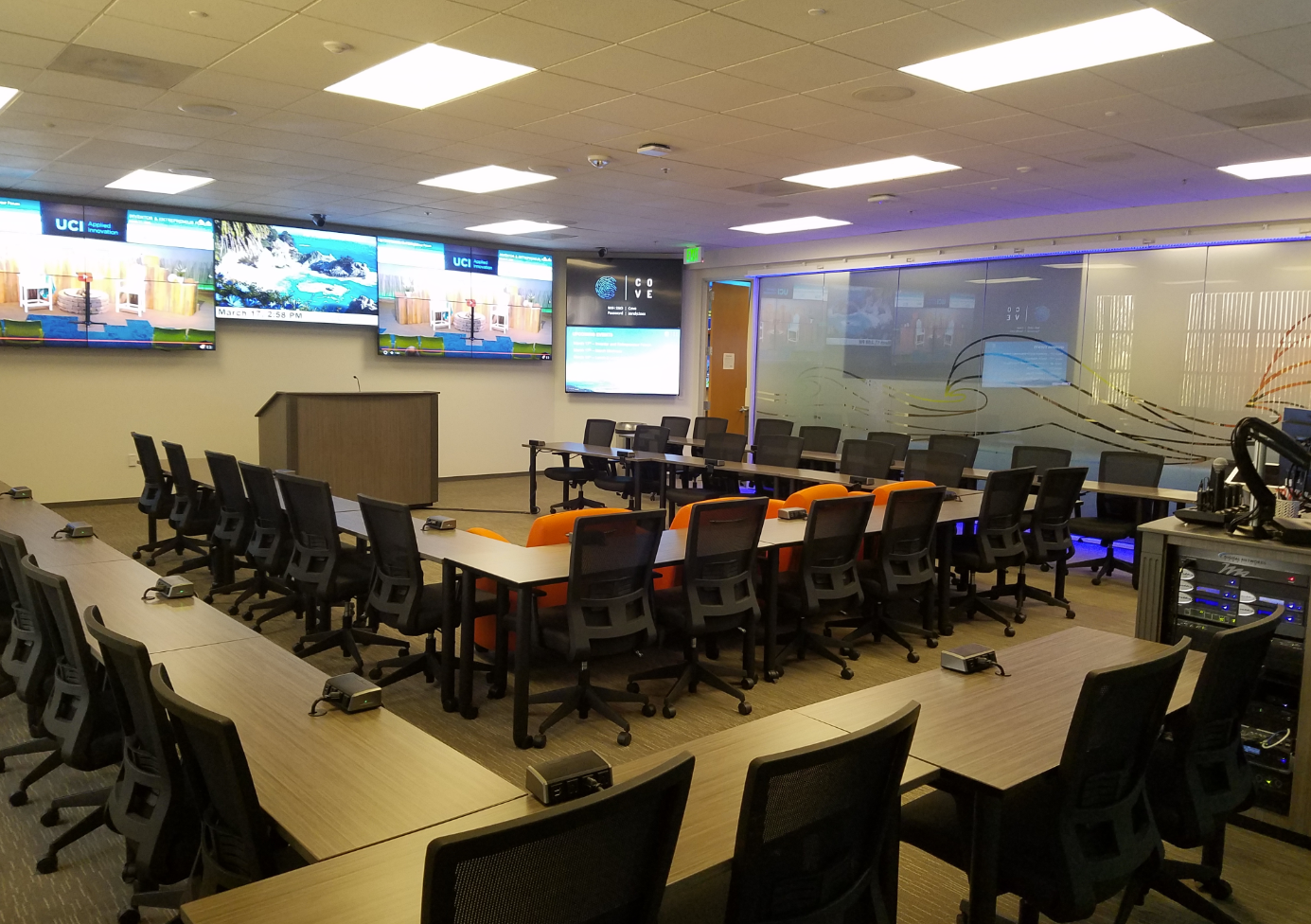
Common Collaborative spaces…
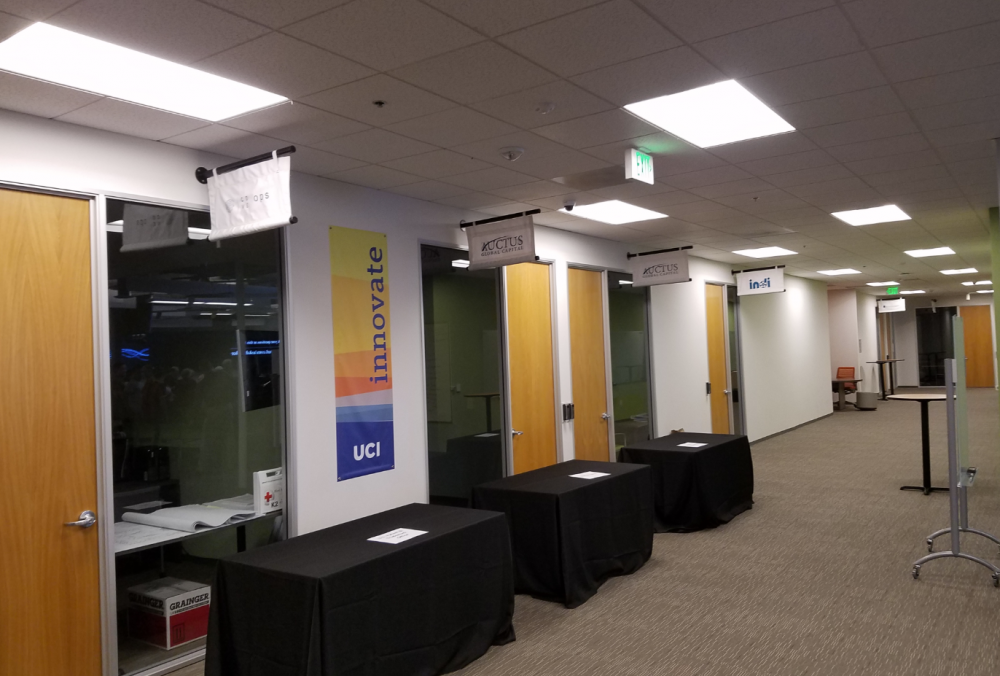
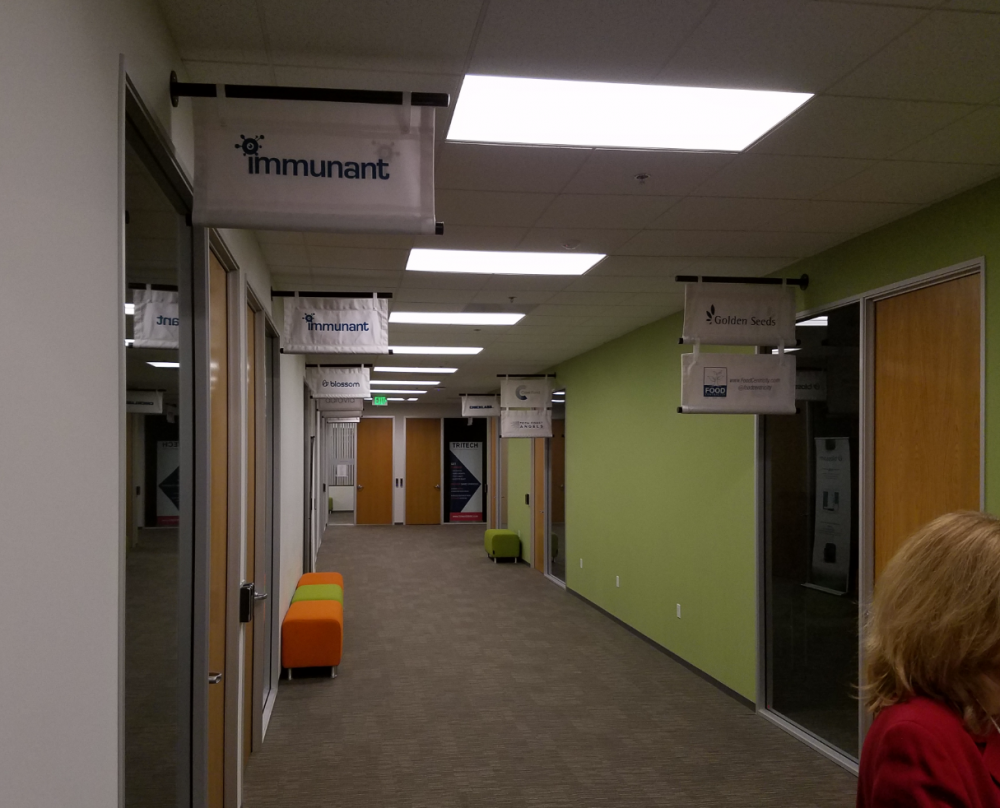



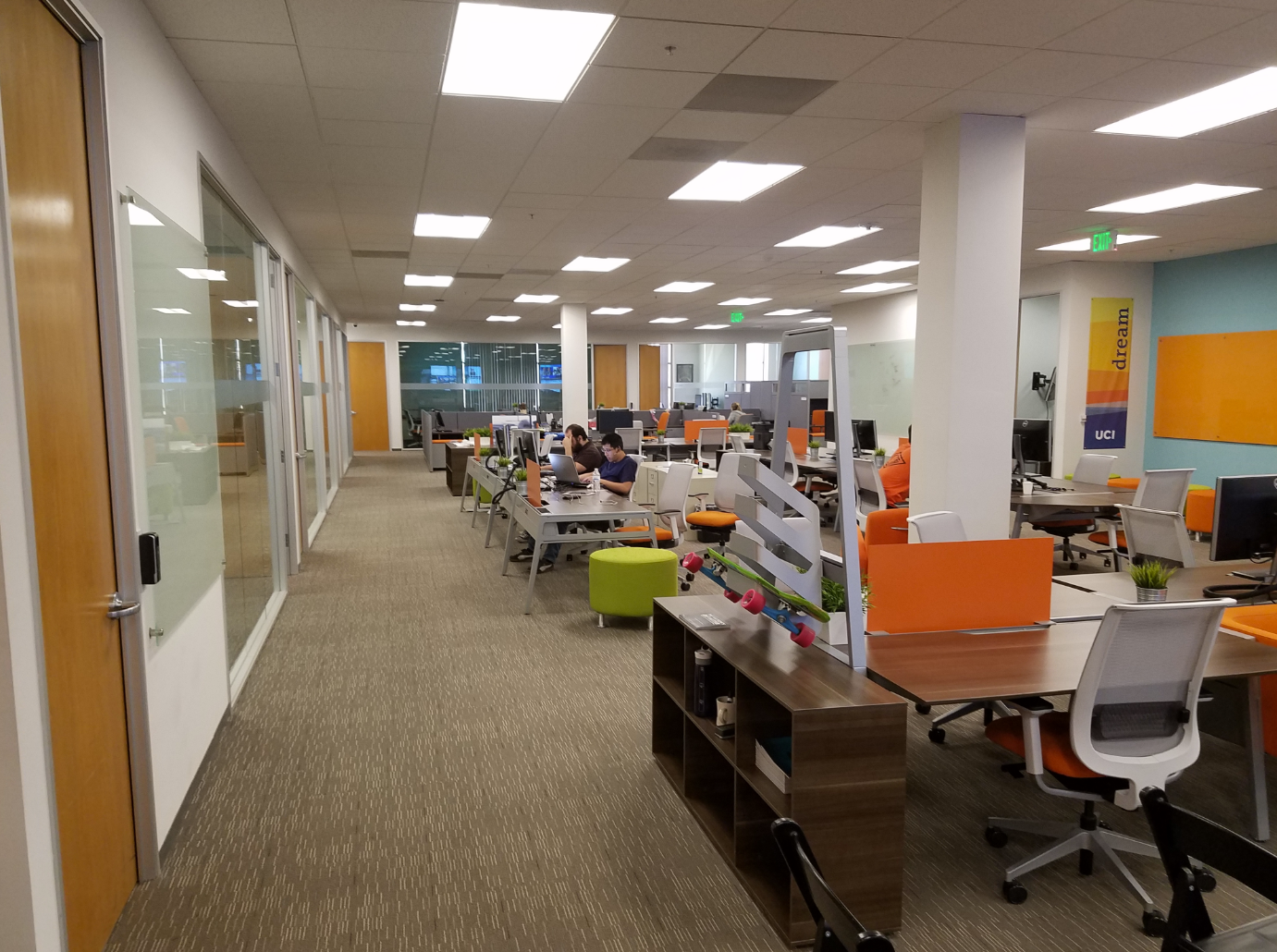


The facility also includes some collaborative dry-lab and wet-lab spaces (not pictured because they were in use at the time).
Although The Cove was certainly impressive, it was only a piece of the puzzle in my head in consideration for this article. As I interacted with more people working at and attending this event my company was co-sponsoring, I began to recognize a growing recognition of the regional differences in attitude about the benefits and needs for a robust innovation ecosystem.
Certainly Davis is not Orange Country. There are a lot of things about Orange County that I do not like. For example, the hotel I stayed at had no restaurants within walking distance. The Irvine-area business parks, and the buildings contained within, lack variation and aesthetics. It is a developer’s paradise, and not so much a paradise for living.
And in comparison to Irvine, Davis is no innovation back-water. Under Linda Katehi’s leadership, UC Davis has made some significant progress growing their technology transfer infrastructure and services. The Office of Research launched the Venture Catalyst entity. The UCD strategic plan identifies goal metrics that speak to the need to foster and grow an innovation ecosystem. Lastly, Davis has some collaborative innovation space and startup incubation and acceleration services (for example, the HM.CLAUSE Life Science Innovation Center and Davis Roots).
However, UCD Davis is behind and playing catch-up in the technology transfer game. But UC Davis isn’t the primary source of the difference I noted… that distinction rests with the residents of the City of Davis.
Land Use and Economic Vitality – Our Davis Disconnect
Everyone I talked to in a leadership position within the Irvine innovation arena agreed that supporting job creation and economic growth for the Orange County region is their ultimate motivational driver and the ultimate target for everything they do.
Certainly some of the big brains behind these businesses are motivated to change the world; however, the primary focus of the entire collaborative force is to benefit their local region.
Thankfully, UCD echoes a similar regional benefit theme from goal metrics within their strategic plan:
- “[increase] The number of business, cultural, service, entrepreneurial and philanthropic partnerships that are developed and that produce visible benefits and/or economic impact.”
- “Increases in the depth and breadth of economic impact on the region that arise from our efforts, as reported in the bi-annual “UC Davis Economic Impact Report;” monitor the economic impact in the state that accrues from the adoption of research technologies that are pioneered at UC Davis.”
- “[Increase] The number of start-up and spin-off companies, and the local, regional and state employment impact of our entrepreneurial partnerships.”
The difference is that UCD and the City of Davis do not line up well on these goals and measures.
There are four main ingredients to a new business startup:
- The marketable idea
This can be a product or service. UCD is full of marketable ideas.
- Human talent
UCD has much of this, but needs mentoring and assistance outside of the science and engineering talent it has in abundance.
- Capital
Davis does not yet attract a breadth and depth of angel and VC investors. But the “build it and they will come” principle has been proven in other regions growing their economic ecosystem.
- Land and facilities
This is where the local region of Davis hits a wall.
I cornered a variety of people at the Irvine event we co-sponsored to get their advice for breaking down this Davis land-use and development “wall”. What I got in return was their befuddlement and disbelief. They just could not comprehend the problem I was asking them to help solve. None of them had any similar experience they could draw on.
Government officials attending told me that, although it was common to experience opposition to new developments from some residents, it was usually housing developments that generated this and not commercial developments growing economic vitality for the region. This point was consistently echoed by others I talked to.
I was actually embarrassed after broaching the subject… it was like I lived in the Appalachian Mountain equivalent of communities embracing the development of a robust innovation ecosystem. Davis is no innovation back-water, but it sure seemed to be the impression I left with these innovation leaders of UC Irvine and Orange County.
Make or Break Measure R Votes: NISHI and MRIC
Where are we today on Davis resident support or opposition for land use supporting UCD technology transfer that is a catalyst for improving local and regional economic vitality? Will Davis voters support growing a robust innovation ecosystem, or will they vote down the NISHI or MRIC projects over concerns of personal lifestyle impacts?
We have been debating the pros and cons of peripheral land use for decades. More recently, especially on the Vanguard, we have been specifically debating the pros and cons of innovation parks.
It is true that a decision to do nothing is still a decision with consequences. My hope is that enough Davis voters now understand the expected impacts and consequences for rejecting or supporting these two innovation parks, and smartly vote to approve them.
Then Davis and UCD can be true partners in the goal of creating a robust innovation ecosystem that benefits the city and region, and the people that call it home.
Davis does not need to be like Orange County. In fact, I would not support that vision. However, Davis does need to break down the wall of opposition to peripheral land use and vote to approve the innovation parks. It is the right thing to do.
“supporting job creation and economic growth for the Orange County region is their ultimate motivational driver and the ultimate target for everything they do.”
“Davis does not need to be like Orange County. In fact, I would not support that vision. However, Davis does need to break down the wall of opposition to peripheral land use and vote to approve the innovation parks. It is the right thing to do.”
And thus is well encapsulated the “grow as fast as we can” philosophy. You state that “Davis does not need to be Orange County” but fail to realize that it is this drive to use economic expansion as the “ultimate target” that has created the Orange County that exists today. I was there when this exact point of view was driving the paving over of orange grove after orange grove and strawberry field after strawberry field. With each new development neighbors were told that this one step was needed to grow the “economy”. Forty years later, the Orange County of today is the result.
No economic growth is not an option. But I would argue for a balanced model that does not see economic growth as the “ultimate target” but rather recognizes that growth should include a holistic vision of what the future can be with a healthy economy, healthy environment, healthy population, and collaborative and peaceful society as equal goals.
” I would argue for a balanced model that does not see economic growth as the “ultimate target” but rather recognizes that growth should include a holistic vision of what the future can be”
Hear!Hear! I too lived in OC (Laguna Beach) in the early 70s. My lovely little shack is now surrounded by mini-mansions and the native flora and fauna decimated. Unless the preservationists in Davis can make affirmative suggestions to accommodate new business and housing, I think that they will be crushed by the developers there, too, simply from the weight of financial obligation and population growth.
A couple of thoughts.
First, I assume you are talking about the orange groves that covered most of the land in Orange County. I’m sure you know that average rainfall in Orange County is about 12 inches… or near desert distinction. You also probably know that Orange County gets most of its water from Northern California and the Colorado River… two sources that have been significantly stressed over the last decade.
Since Orange County is near desert in rainfall, there really isn’t much natural native flora and fauna decimated by development. However, orange groves have been decimated. And orange groves tend to require a lot of irrigation. And when you calculate the human benefit per gallon of water needed for an orange grove compared to the gallon of water needed by an innovation park, I think you are going to be hard-pressed to make a case for the orange grove being superior.
The last thought relates to your comment about your shack being replaced by mini-mansions. This seems largely just your personal life-style bias. And I thank you for making your point, because I see this as the basic conflict in Davis. I see attempts to mask the lifestyle bias by pulling in environmental concerns. But like Orange County, the orange groves were not part of the natural habitat. They were just one type of business-use of the land… and one that uses a lot of water… which is actually a negative environmental concern.
Certainly the few people lucky enough to live in Orange County when it was farmed in orange groves would have loved the look and feel of the land… they would have valued their lifestyle… small shack or not. But it would not be right to withhold development that serves to benefit many over the lifestyle benefits of a few. Instead, it would be right to develop smartly to preserve as much of the old lifestyle benefits while also serving more of humanity. Orange County failed at this, but Davis does not need to follow that same path. Davis is not following that same path.
Davis will not be crushed by developers unless we settle into us (the old lifestyle protectorate) versus them (the new innovation ecosystem growth advocates) and the old lifestyle protectorate loses. Instead of this fight, we should be working together to ensure smart growth and development.
“First, I assume you are talking about the orange groves that covered most of the land in Orange County. ”
Whatever made you assume that? Yellow mustard plants were the only nonnatives outside of small garden patches in Laguna. The canyon was still a wild place, save for a few small houses and an old lovely terraced estate on the south canyon wall, full of coyotes, rodents, reptiles, birds, insects, wild flowers and species of cactus and other low growing brush and trees.
Got it. The desert can still be beautiful and appealing.
Southern California is largely chaparral, not desert, in the area you are describing, and the native flora and fauna are well-adapted to the natural rainfall. There is a common misconception in Northern California that Southern California has no natural areas, that all the plant communities are barren or desert, and that there was nothing worth conserving there.
The neighborhood I grew up in included a canyon, owned by the homeowners association, which has been conserved in partnership with the Nature Conservancy. Yes, there are cactus, along with many other interesting plants. No, it is not desert. Yes, they are worth conserving.
Here is an outstanding reference for information about California’s many plant communities: http://www.laspilitas.com/nature-of-california/communities
Orange county had a history of being ranch land and farm land and then orange groves Most of the development that happened beginning in the 1950s was replacing the orange groves and other farmland/ranch land, not the remaining unspoiled natural habitat.
Today in California there are plenty of tools used by environmentalists to block development on natural habitat. I think it is disingenuous to attempt to use this argument in opposition of innovation park development when most if not all of that development is going on land that is already being used for commerce.
In other words, it isn’t so much the natural environment that is being protected as it is the views of farm fields and orchards that are being protected.
Thanks, Don. I appreciate the effort to educate folks who may be a bit un-inquisitive and extremely presumptuous about Southern Cal. The beauty of the south-west’s chaparral and high desert attracts many of my British and European friends to California.
Smart growth and development principles were not in vogue back when Orange County was experiencing rapid development expansion. There is no reason to assume that Davis would be anything like Orange County after developing some innovation parks on our periphery. The plans for the Nishi and MRIC developments already support many Smart development principles.
“The plans for the Nishi and MRIC developments already support many Smart development principles.”
Do you think that a “education” campaign can be successfully mounted to convince Davisites of the virtues of those two developments?
I think so. I expect there to be more chatter and marketing material in advance of the elections. Of course it will come from both sides. I except them both to pass, but then I don’t hold a crystal ball.
Jeff- the Cove sounds great and is almost exactly the same size and description of what our company is developing on Research Park Drive just a quarter mile from downtown Davis at our recently purchased “Area 52” facility (the former Flying Car factory). I totally agree with you that this is the kind of facility needed by a community like Davis to foster innovation.
https://www.ucdavis.edu/news/uc-davis-area-52-establish-new-business-incubator-davis
Mike – Thank you for reminded me of this. I forgot to include it in the list. I need to get together with you and Robb (and ??) to have a similar conversation as we have been having with the Orange County folks to make sure we are connecting these startups with their small business debt financing options. Those services tend to be downstream in the business development life-cycle, but there is more help available than these entrepreneur tend to not know about.
Jeff – Mike Hart is certainly understating his (and other’s) vision for Area 52. Mike purchased the 35,000+ sq ft Moller International building on Research Park Drive (heavy manufacturing tooling and all) back in June 2015 to assist the Sierra Energy engineering team in developing our FastOx Gasification technology.
Since then, Mike, Tim Keller (the non-profit executive director), Sierra Energy staff and community leaders have been busy planning for an incubator/makerspace. We have had visitors at Area 52 from UC Davis, City of Davis, other US-based universities, national labs, local economic development organizations, investor groups, entrepreneurs, and businesses. And just this week, our first city council member from Davis came by (Rochelle Swanson) to hear about the vision and identify how she could lend support.
There is a public open house in the works, likely for mid-April. And you can learn more about the vision for Area 52 and keep up-to-date on our progress at http://www.Area52.space.
I always loved the smell of black sage and the vibrant colors of paint brush, monkey flower, lupine and California poppy. Of course we don’t have much of that here. Our conversion issues are more about tomatoes and sunflowers not nearly the same as orange groves. The big loss for Davis has been the decline in the burrowing owl population perhaps an unintended consequence of the desire to preserve coyotes in addition to development on suitable owl habitat. If it was up to me we would build what we need yet at the same time do what we need to save the local owl population. The preservation of the owls should be our number one mitigation effort. The interesting problem with infill is that it often brings conflict with existing neighborhoods such as Trackside, Paso Fino, Koso, Lincoln 40. Its actually easier to build new peripheral projects except in Davis where we have hemmed ourselves in with measure R.
This is a very good article. edit I wonder how many more readers would have looked at this if they weren’t so turned off by his usual right wing boilerplate edit. When he sticks to economic issues that he actually knows something about he can write some good thoughts and add a rational perspective about the local scene. He ought to do more of that and less of the other.
moderator: edited.
Apologies to Jeff Boone that such ugly comments are directed towards a guest contributor.
[moderator: examples edited. Thanks for flagging the comment. I was busy with other things this morning.]
“…that such ugly comments are elicited by a guest contributor. ”
Fixed it for ya.
+1-“When he sticks to economic issues that he actually knows something about he can write some good thoughts and add a rational perspective about the local scene. He ought to do more of that and less of the other.”